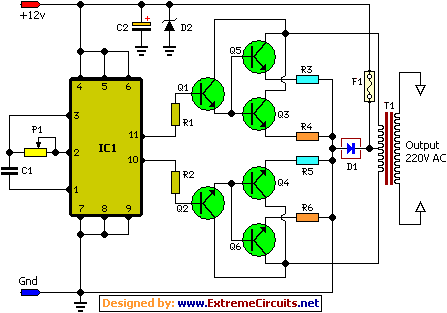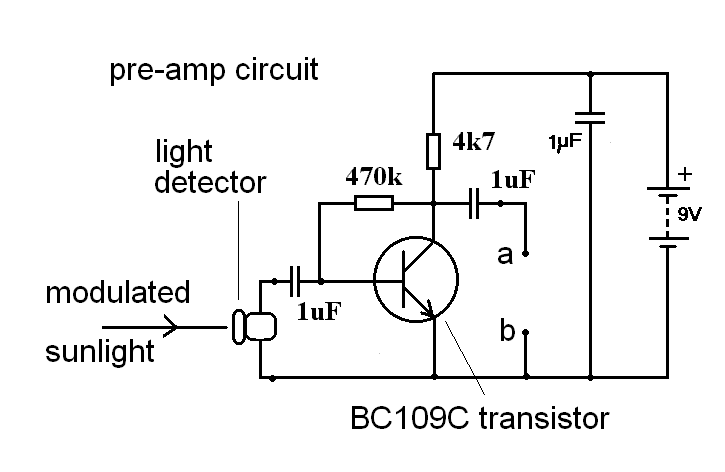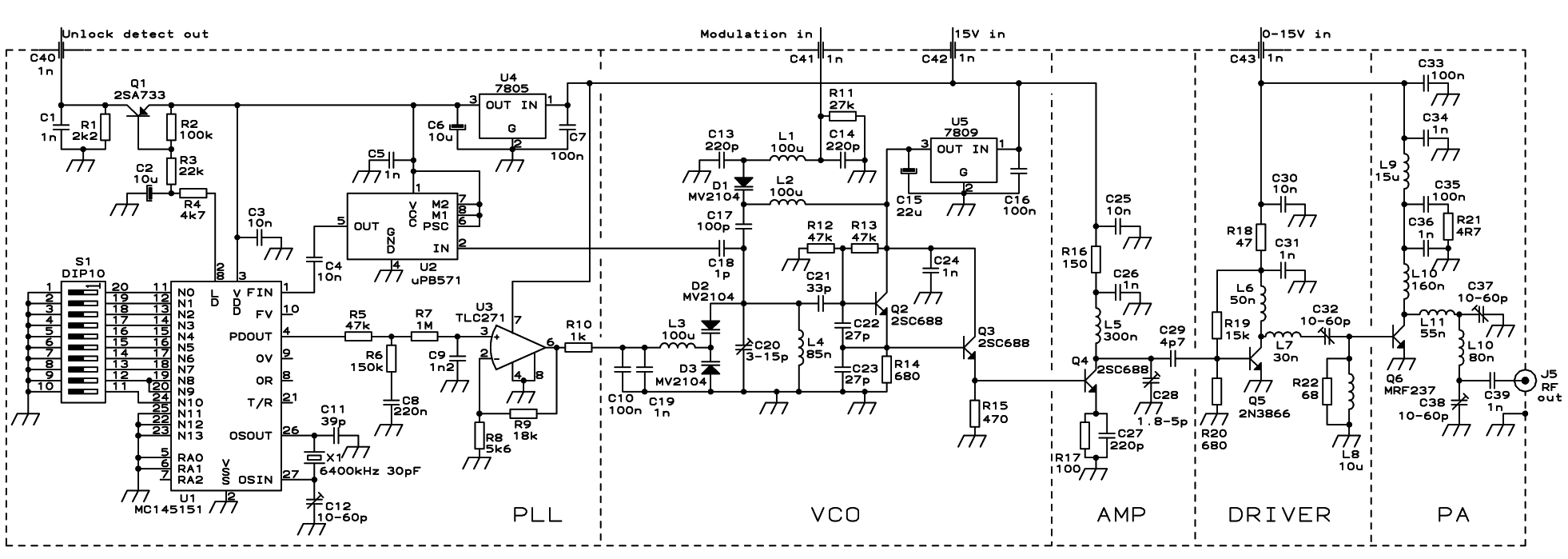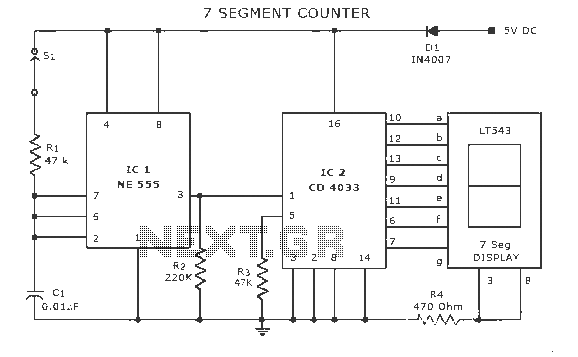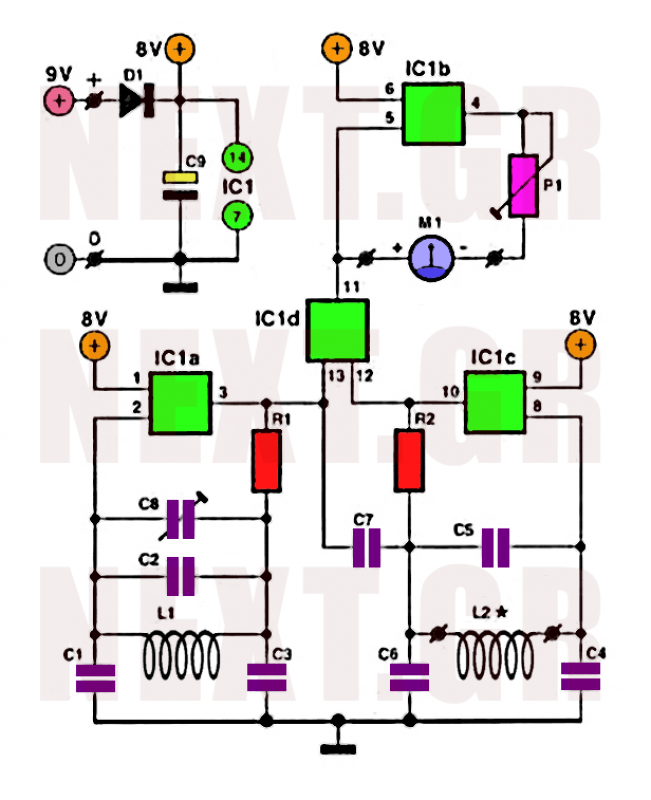
An electronic music rotating lights circuit
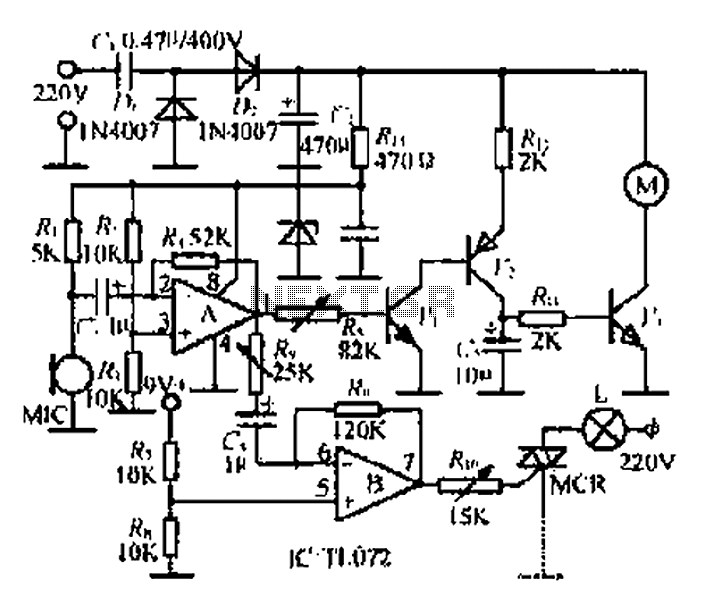
A microphone (MIC) is used to capture sound, which is then converted into a voltage signal. An operational amplifier (op-amp A) acts as a buffer; one output is directed to a motor drive circuit to control the motor's rotation in sync with the music rhythm, while the other output connects to a second op-amp (op-amp B) that controls a bidirectional silicon-controlled rectifier (SCR). The lamp (L) varies its brightness in accordance with the music rhythm, creating a strong sense of rhythm. The signal from the microphone is amplified by op-amp A, as the initial signal strength is weak. Following this, a transistor (U) amplifies the audio voltage significantly, which then drives the motor control circuit. Consequently, as the microphone picks up the music signal, the motor rotates in harmony with the music's rhythm, and the lamp's brightness changes with the music's intensity. The circuit also includes a constant-speed rotating light effect. The output from op-amp A provides a tone signal that ensures the music's weaker signals are amplified adequately, allowing the circuit to function even in less intense sound environments. The lamp's brightness can be adjusted based on the light sensitivity, with a potentiometer available for fine-tuning. The power supply consists of a rectifier circuit that stabilizes the voltage, ensuring a normal operational voltage of around 9V for the motor drive circuit.
The circuit described operates by utilizing a microphone to detect ambient sound, which is then processed through a series of amplification stages to control both a motor and a light source. The initial sound captured by the microphone is converted into an electrical signal, which is typically weak and requires amplification. The first operational amplifier (op-amp A) serves to buffer this signal, ensuring that it is strong enough for further processing.
The output from op-amp A is split into two paths: one feeds into the motor drive circuit, while the other is sent to a second operational amplifier (op-amp B). This second op-amp is configured to control a silicon-controlled rectifier (SCR), which regulates the power supplied to the lamp (L). This setup allows the lamp to vary its brightness in real-time with the rhythm of the music, enhancing the visual experience.
The motor control circuit is designed to rotate the motor in synchronization with the music, providing a dynamic and engaging effect. The motor's speed and the lamp's brightness are both influenced by the amplitude of the audio signal, which is further amplified by a transistor (U) to ensure sufficient voltage is available to drive the motor effectively.
In addition, the circuit includes provisions for adjusting the sensitivity of the light response via a variable resistor (potentiometer), allowing for customization based on the specific environment or user preference. The power supply for the circuit is stabilized by a rectifier, ensuring that the operational voltage remains consistent, typically around 9V, which is essential for reliable performance of the motor and lamp control systems.
Overall, this circuit design effectively integrates audio signal processing with motor and light control, creating an interactive experience that responds to sound in a visually appealing manner. Circle MIC to lift the damper after it is converted into a voltage signal sounds, the op amp A buffer enemy, one road goes to the motor drive circuit for controlling the motor to rotate with the music rhythm; the other way to the break op amp B made into stride k controls the bidirectional -U Zhu silicon MCR, the lamp L with the rhythm of the music and continuous coup brightness to produce a strong sense of rhythm, the signal is picked up by the microphone mIC op amp a amplification, the signal strength is small, and then after three pull tube u U two high-gain directly amplified in the transistor U of C pole BU is greatly audio voltage which by c, RII a slide after driving straight fight n c motor control team work, so when the MIC pickup after the music signal, the motor will continue to rotate with the rhythm of the music changes. M leaving the lights appear rotation speed changing color rotation, rotation Bong circuitm outfitting constant speed rotating lights that effect Tiao single heir.
B op amp output of op amp A tone signal progress Music release, Making music weaker signal can be picked up amplified sound guarantee Bong circuit in music often work less intense environment hf, the lamp L can be silicon Lang with music and rhythm to change the brightness. closed in wind motor control most acuity San Cave resistance, R. sensitivity to lights made lemon trimming resistor, if necessary, where, can make the team sheet j potentiometers for easy adjustment.
power hungry ff/towels electricity through electricity stored C- buck .DI Ma rectifier supply circuit r irresolute, live electrical hole in a wall ends. about 18V linear fi + f: IU pressure. Address field drains drive motor circuit work normal work ashamed {f voltage generated by VD stable at 9V.
The circuit described operates by utilizing a microphone to detect ambient sound, which is then processed through a series of amplification stages to control both a motor and a light source. The initial sound captured by the microphone is converted into an electrical signal, which is typically weak and requires amplification. The first operational amplifier (op-amp A) serves to buffer this signal, ensuring that it is strong enough for further processing.
The output from op-amp A is split into two paths: one feeds into the motor drive circuit, while the other is sent to a second operational amplifier (op-amp B). This second op-amp is configured to control a silicon-controlled rectifier (SCR), which regulates the power supplied to the lamp (L). This setup allows the lamp to vary its brightness in real-time with the rhythm of the music, enhancing the visual experience.
The motor control circuit is designed to rotate the motor in synchronization with the music, providing a dynamic and engaging effect. The motor's speed and the lamp's brightness are both influenced by the amplitude of the audio signal, which is further amplified by a transistor (U) to ensure sufficient voltage is available to drive the motor effectively.
In addition, the circuit includes provisions for adjusting the sensitivity of the light response via a variable resistor (potentiometer), allowing for customization based on the specific environment or user preference. The power supply for the circuit is stabilized by a rectifier, ensuring that the operational voltage remains consistent, typically around 9V, which is essential for reliable performance of the motor and lamp control systems.
Overall, this circuit design effectively integrates audio signal processing with motor and light control, creating an interactive experience that responds to sound in a visually appealing manner. Circle MIC to lift the damper after it is converted into a voltage signal sounds, the op amp A buffer enemy, one road goes to the motor drive circuit for controlling the motor to rotate with the music rhythm; the other way to the break op amp B made into stride k controls the bidirectional -U Zhu silicon MCR, the lamp L with the rhythm of the music and continuous coup brightness to produce a strong sense of rhythm, the signal is picked up by the microphone mIC op amp a amplification, the signal strength is small, and then after three pull tube u U two high-gain directly amplified in the transistor U of C pole BU is greatly audio voltage which by c, RII a slide after driving straight fight n c motor control team work, so when the MIC pickup after the music signal, the motor will continue to rotate with the rhythm of the music changes. M leaving the lights appear rotation speed changing color rotation, rotation Bong circuitm outfitting constant speed rotating lights that effect Tiao single heir.
B op amp output of op amp A tone signal progress Music release, Making music weaker signal can be picked up amplified sound guarantee Bong circuit in music often work less intense environment hf, the lamp L can be silicon Lang with music and rhythm to change the brightness. closed in wind motor control most acuity San Cave resistance, R. sensitivity to lights made lemon trimming resistor, if necessary, where, can make the team sheet j potentiometers for easy adjustment.
power hungry ff/towels electricity through electricity stored C- buck .DI Ma rectifier supply circuit r irresolute, live electrical hole in a wall ends. about 18V linear fi + f: IU pressure. Address field drains drive motor circuit work normal work ashamed {f voltage generated by VD stable at 9V.
Warning: include(partials/cookie-banner.php): Failed to open stream: Permission denied in /var/www/html/nextgr/view-circuit.php on line 713
Warning: include(): Failed opening 'partials/cookie-banner.php' for inclusion (include_path='.:/usr/share/php') in /var/www/html/nextgr/view-circuit.php on line 713
